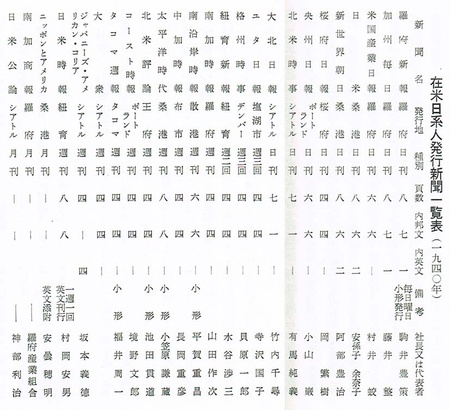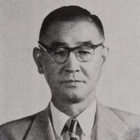Last time, I briefly touched on the strike issue surrounding Rafu Nichibei, the Japanese newspaper in Los Angeles where Kato Shinichi worked as a reporter, but this point is written in more detail in the section "Publications by Japanese Americans in the United States" in the "Centennial History of Japanese Americans in the United States," which Kato edited.
According to the book, Abiko Hisataro, who was also a businessman, founded the newspaper "Nichibei" in San Francisco, and then expanded into Los Angeles, where he acquired "Hokubei Hochi" (first published in 1915) and founded "Rafu Nichibei."
At the San Francisco newspaper "Nichibei" (Japan-America), a conflict arose between the president, Hisataro Abiko, and the employees, leading to the president asking the editorial staff to quit. In response, the employees demanded the reinstatement of those who had left and payment of unpaid wages, but their demands were not accepted, leading to a strike.
At that time, Kato, who was working at Rafu Nichibei in Los Angeles, represented the employees of Rafu Nichibei and went to San Francisco with one colleague to mediate the dispute between the sister paper, Nichibei. However, "while Nichibei had initially accepted the settlement proposal, they changed their mind the next morning, so Kato immediately flew back to Rafu and reported this to the employees, finding that the company was not sincere," and Kato and the other three executives left the company after receiving three months' unpaid wages.
This episode seems to illustrate Kato's character, which was to put into action what he believed to be right, but a similar incident occurred after the war when Kato was working as a reporter for the Chugoku Shimbun.
In the American Industrial Daily
After "Rafu Nichibei," Kato was a prolific writer for the launch of "California Mainichi" in 1931, but in his profile he says, "From 1933, he served as secretary of the Southern California Central Agricultural Association and manager of the Southern California Agricultural Association Federation, during which time he founded the morning Rafu agricultural product market report broadcast." It seems that he also worked as a reporter for California Mainichi for a while.
Perhaps making use of his experience in agriculture, he gained the support of farmers and became editor-in-chief of a newspaper called "Beikoku Sangyo Nippo" in 1937. According to "A Hundred Years of Japanese Americans in the United States," "The paper was originally published by Kato as a weekly bulletin while he was serving as secretary of the Southern California Agricultural Association Federation, and later, with the cooperation of Numata Rihei and others, and the backing of influential people such as Sasaki Masami, it was reorganized in 1938 as a daily newspaper called "California Sangyo Nippo" and changed its name to "Beikoku Sangyo Nippo," with a base throughout Southern California."
Numata Rihei, who appears here, was from Hiroshima, just like Kato, and after the war he became a reporter for the Chugoku Shimbun, just like Kato, in his hometown of Hiroshima.
The American Industrial Daily News "was an advantageous position as it was a morning edition whereas most daily newspapers were evening editions (published in the afternoon), and it continued to be published until the outbreak of war between Japan and the United States" 1 .
The paper also came to rival the Rafu Shimpo and California Mainichi, and when subscription fees were raised, the three papers jointly ran advertisements in their pages.
Japanese newspapers spread across the United States
As of 1940, the year before the outbreak of war between Japan and the United States, in addition to these three papers, Los Angeles had the weekly Southern California Times, and the coastal city of San Pedro had the Southern California Coast Times. In central California, Fresno had the Central California Times, and the state capital, Sacramento, had the Sakurafu Nippo.
In the San Francisco area, there was the "Nichibei" newspaper, which was founded in 1899 and had readers all over the United States, and the "Shinsekai Asahi" newspaper, which also had a wide readership. The latter was formed in 1935 by the merger of the "Shinsekai Nichibei" newspaper and the "Hokubei Asahi" newspaper. Other newspapers included the weekly "Taipei Jidai" newspaper.
According to "A Centennial History of Japanese Americans in the United States," at that time there were 25 Japanese newspapers published across the country.

Kato, who edited the "Complete Guide to Japanese Industries in the United States" in 1940, returned to Japan once that same year. In the August 4, 1940 edition of the Nichibei newspaper, there is a small article entitled "Kato Shinichi Returns to Japan on the Kamakura Maru." The article states that Kato, editor of the Los Angeles Sangyo Nippo newspaper, had traveled to Japan with his wife on the Kamakura Maru and was returning to America after a four-month stay, so he visited the Nichibei-sha newspaper to say goodbye. As the article states, Kato, who is believed to have returned, continued to serve as editor-in-chief of the newspaper.
The following year, on May 21, 1941, the California Mainichi carried a three-paragraph article under the headline "American Industrial Daily Newspaper Company's Seventh Anniversary Commemorative Performance: A Deluxe Edition Featuring All the Top Masters."
The list of performers and the program of the event are listed, and one item reads, "Long live our American compatriots, Editor-in-Chief Kato Shinichi." It is likely that Kato, as editor-in-chief, led the cheer.
There may not have been much of a sense of urgency about the outbreak of war at this time. However, the front page of the paper bore the headline, "British newspapers openly plead for America to join the war. Weapons and comfort bags are not enough." As "news from London," the article reported that a British newspaper, already fighting Germany, was calling in its editorials for America to join the war in order to win the war against Germany.
About six months later, the Japanese military attacked Pearl Harbor in Hawaii, and Kato, who was the editor-in-chief of a Japanese newspaper, was arrested by the Federal Bureau of Investigation.
(Titles omitted)
Note
1. "Japanese Newspapers in America" (Akihiko Haruhara, Sophia: A Study of Western Culture and East-West Cultural Exchange, 28 (4), 1980-01-15)
© 2021 Ryusuke Kawai






